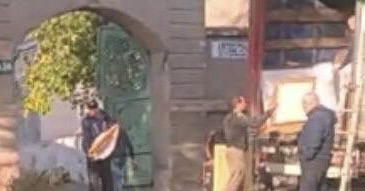

By
Stewart Bell &
Jeff Semple
Global News
Published February 21, 2023
9 min read

KHERSON, Ukraine — The thieves entered the museum on October 31, removed the paintings from their frames and loaded them onto cargo trucks.
It took them four days to empty the Kherson Regional Art Museum, known as the Louvre of Kherson, and make off with more than 10,000 works by Ukrainian, Russian and European painters.
Police are investigating, but who did it is no mystery. Russian forces looted the museum and three others as they retreated from Kherson city late last year.
“They stole everything,” said Alina Dotsenko, the art museum’s director, who ranked the incident as worse than the Nazi plundering of the city in the 1940s.
To Dotsenko, what happened in Kherson was not just an armed robbery. It was part of a wider Russian campaign to deny Ukrainians their existence as a distinct people and nation.
The full-scale invasion ordered by President Vladimir Putin one year ago this week was a land grab, but it was premised on Moscow’s claim that Ukraine is not a real country.
Although Kyiv is hundreds of years older than Moscow, Putin has attempted to justify his war with an interpretation of history that asserts that Ukraine is part of Russia.
For many Ukrainians, the widespread attacks on cultural institutions of the past year are an attempt to erase their heritage and absorb them into an empire-minded Russia.

Hanna Skrypka, the Kherson art museum’s deputy director, estimated the Russians stole 80 to 85 percent of the collection of 14,000 works, including those by Ukraine’s masters and rare depictions of its past.
“This was the proof of our identity,” she said.
A week after the Russians cleaned out the museum, Ukrainian forces pushed them out of Kherson city and back across the Dnieper River.
But the Russians weren’t done.
On Nov. 30, they shelled the museum with artillery.
The St. Catherine’s Cathedral was a museum of atheism during the years when the Soviet Union controlled Ukraine. It re-opened as an Orthodox church in 1991, when Ukraine gained independence.
Inside the thick sandstone walls, Father Vitaly lifted a trap door set into the wooden floorboards and descended a staircase to a dank room.
The crypt beneath the church was the tomb of Grigory Potemkin, Kherson’s founder and the lover of Russian empress Catherine the Great.
The grave is empty now. The casket is gone. So are Potemkin’s bones, which were kept in a cloth bag. Ten Russian soldiers spirited them away, claiming the Ukrainian military was planning to bomb the church.
Instead, after looting the 18th-century cathedral, the Russian army fired artillery at it. One shell landed in the grass near the columned entrance. Father Vitaly said emergency services workers removed the rocket the day before.
More shells hit the park directly behind the church, and when the Russians blew up the TV tower next door, the explosion shattered the church windows.
“Thank God, nothing else,” he said.
Before the invasion, the cathedral served a congregation of about 350, and three times as many at Easter and Christmas. But the river that has become a frontline is close, and no more that 60 turn up now.
“A lot of people left the city, and this part of the city is really under constant shelling,” the priest said. “So they are afraid.”
“The city is empty, like a ghost city, but thank God the people survive and come back and everything will be as it was before.”
But it won’t be exactly as it was, not since the grave-robbers dropped by. Father Vitaly said Potemkin’s remains were just bones. “We don’t need to be so upset about it. It’s not religious, just historic.”
“History is in the heart of the people, the memory of people. A lot of things were lost but the major part is we should remember who we are. History is good but the main thing is life.”
He said he tells his congregants not to be angry, and to support each other because the suffering will end.
“All wars finish,” he said.
Russia’s assault on Ukrainian cultural sites has been relentless. According to UNESCO, 240 of them have been damaged in the past 12 months — 105 churches, 86 buildings of historical or artistic interest, 19 monuments, 18 museums and 12 libraries.
During the last three weeks of the Russian occupation of Kherson city, Russian forces looted not only the art museum and cathedral, but also the history museum and national archives.
Members of Russian’s FSB security service arrived at the Kherson Regional Museum on Oct. 24 and stole silver, gold, Greek vases and war relics, according to Human Rights Watch.
From the archives, Russian forces took 18th and 19th century documents, maps, urban plans, pre-war newspapers, and almost everything related to the pre-revolutionary period, Human Rights Watch said.
“Kherson residents had already suffered months of torture and other abuses during the Russian occupation, and then watched their cultural and historical heritage get packed up and taken away,” the group added.
“This systematic looting was an organized operation to rob Ukrainians of their national heritage and amounts to a war crime for which the pillagers should be held to account.”
But instead of erasing Ukrainian nationalism, the war appears to have invigorated it.
Outraged at Putin, many Russian-speakers have renounced the language. Ukrainians have changed street names and torn down statues associated with Russia.
In Kyiv, a monument to Ukrainian-Russian friendship was dismantled. An Odesa street was renamed after Boris Johnson, the former British prime minister.
Ukrainians call it derussification and decolonization.
In the basement of Kherson’s art museum, gold-painted picture frames with ornate edging were stacked against the walls. They were all the Russians left behind.
On the morning the Russians began fighting their way into Kherson from the south side of the river, Dotsenko went up to a rooftop and looked at the Antonivskyi Bridge.
“I wanted to blow it up,” she said.
But the Russians quickly seized the city, and she focused on trying to save her museum. Dotsenko had worked there since it opened in 1978. The artworks were like her children.
“It was my life,” she said.
At the time, the three-storey structure, once the city hall, was undergoing renovations. It was fenced off and the paintings were kept in a storage room.
Since the gallery walls were mostly bare, Dotsenko tried to maintain the ruse that the artworks had been moved due to the construction.
And for a time, it worked.
To support the facade, she kept staff she knew she could trust, and sent the rest home to work remotely. Plainclothes Kherson police who were part of the city’s partisan movement quietly replaced her security guards, she said.
On May 2, the Russians set up a checkpoint nearby, and a dozen gunmen entered the gallery by breaking down the door. They handcuffed the guard face down and took his keys.
Two days later, a man phoned Dotsenko and introduced himself as part of Kherson’s new administration. He would not give his name but asked her to organize an exhibition at the government building.
She told him the museum was empty, but he responded that was a lie and he knew everything. He told her to report to his office at 9 a.m. “We will teach you to respect the new authorities,” he said.
She knew what that meant. She had heard from her police contacts the Russians were arresting their opponents and locking them in detention centres known as basements to be tortured and executed.
That night, she packed a bag and left the city, leaving her deputy, Hanna Skrypka, in charge.
Dotsenko believes the museum was betrayed by two former employees who collaborated with the Russians.
She doesn’t know what else she could have done. The city was under occupation. Checkpoints clogged the streets. Sneaking out thousands of artworks was an impossible task. “How?” she asked.
On July 19, the Russians returned to the museum and appointed a local lounge singer as the new director. They searched Skrypka’s home and took her phone and the museum keys.
“They asked where is the most valuable, expensive work,” Skrypka said. She refused to help them, she said, and was told to stay home, but she kept watch on the museum, peering through fences to monitor what the Russians were up to.
At the end of October, the Russians called Skrypka back to the museum and told her to make a list of all the artworks. They locked her inside and did not permit her to leave for two nights, she said.
The Russians who came to take the paintings seemed to know what they were doing. “To see their actions, in reality they are representatives who have a background in museums,” Skrypya said.
About 70 workers were involved. While they handled the art carefully at first, they became more reckless as they ran out of time and did not use gloves.
The streets outside were closed. Five trucks and two school buses were parked outside. Everything was carried into the vehicles.
“We saw how they moved it out, like rubbish,” Dotsenko said.
Locals filmed the operation discretely with their phones. Satellite images captured two moving trucks and a van parked outside on Nov. 1. But nobody could stop it.
Dotsenko was despondent to see her life’s work being loaded into “dirty trucks.” It was like watching her kids being kidnapped, she said. “I had the feeling I’m dying.”
The paintings that were taken included portraits, landscapes and still lifes dating back hundred of years: “Cossacks in the Steppe,” by Serhiy Vasylkivsky; and “On the Dnipro. Kherson,” by Oleksii Shovkunenko.
“All of the time the Russians try to destroy our culture,” she said. “It was always like this.”
Skrypka also believes the Russians didn’t want to leave behind any traces of Ukrainian identity, nothing that would show how Ukraine is distinct from Russia.
“I think they want to collect memory,” she said.
The theft has ruptured Kherson’s links to its past, she said. She wants the collection back. “We have hopes that most of our works will return,” she said.
“Yes, we are hoping.”
By scanning social media, museum staff have traced some of the artworks to the Central Taurida Museum in Simferopol, a city in Crimea, the Ukrainian region that Russian troops invaded in 2014.
Photos show the paintings being carried into the entry hall and stacked against walls. In one, a woman walked past a stolen piece, “The Ancient Walls of Vilnius,” by Augustunas Savockas. It was casually upended at the end of a pile.
Victor Zaretskyi’s “Still Life With Flounder” was spotted in another photo, sitting on the floor of the Crimea gallery. Precious artworks treated like garage sale offerings.
Dotsenko said staff were working to locate them. She doesn’t know if the entire collection was moved to the Crimea museum or if it was scattered.
The world needs to know what Russia did, she said, and those responsible must be brought to justice for their attack on Ukraine’s heritage.
“The people loved our museum so much,” she said. “It was really a temple.”
Stewart.Bell@globalnews.ca


Comments